Honor Award
Resuscitating the Fez River
Fez, Morocco
Bureau E.A.S.T., Fez, Morocco
Client: Régie Autonome Intercommunale de Distribution d'Eau et d'Electricité de Fès (RADEEF)
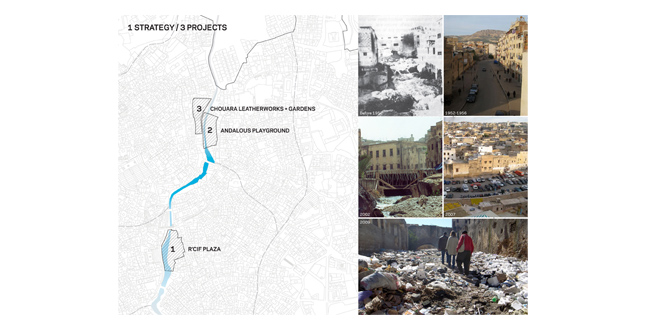 Close Me!
Close Me!Site Plan
Download Hi-Res ImagePhoto 1 of 15
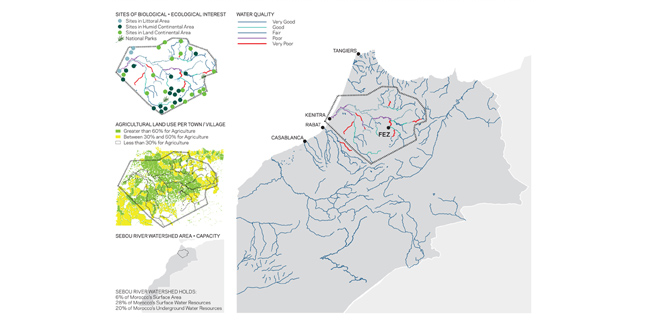 Close Me!
Close Me!The Sebou River Basin. The city of Fez is located within one of Morocco’s most fertile valleys, the Sebou River Basin. Data reveals that the river is relatively clean before reaching the medina and that contamination, mainly chromium, emerges from within—presumably by discharge from the Chouara Tanneries. Given the importance of this river basin to Morocco’s agricultural sector and its overall economy, it is imperative that contamination be reduced or removed at its source and strategies for remediation be implemented.
Download Hi-Res ImagePhoto: Ahlam Zainal
Photo 2 of 15
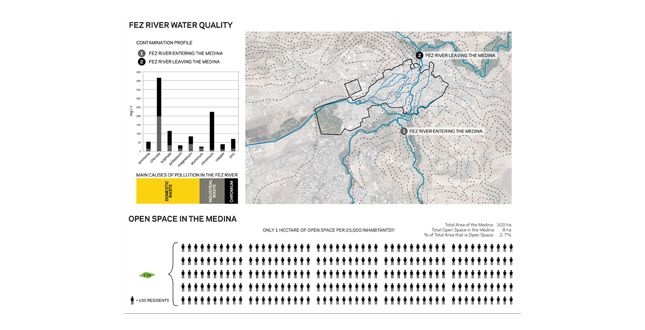 Close Me!
Close Me!Fez River Water Quality
Download Hi-Res ImagePhoto 3 of 15
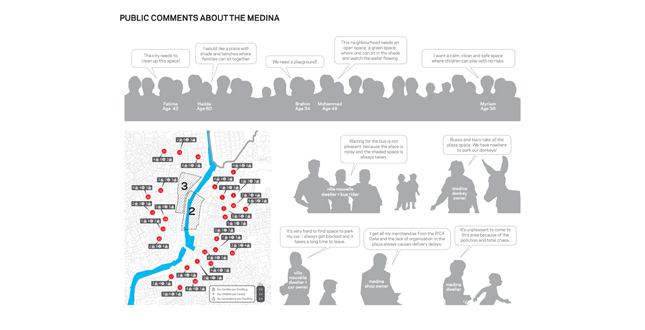 Close Me!
Close Me!Public Comments About the Medina
Download Hi-Res ImagePhoto 4 of 15
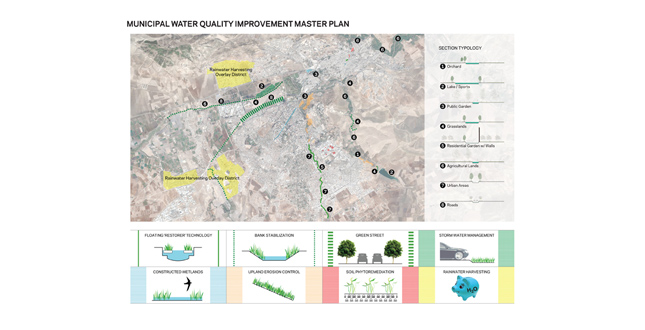 Close Me!
Close Me!Municipal Water Quality Improvement Master Plan
Download Hi-Res ImagePhoto 5 of 15
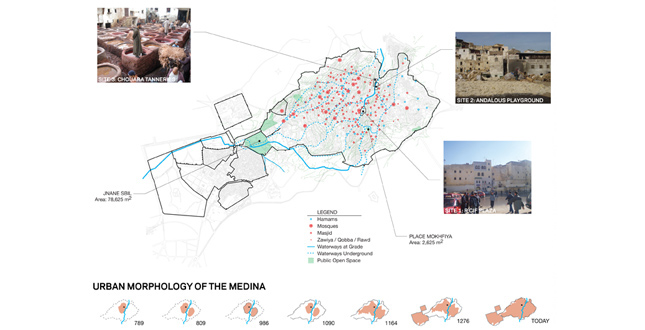 Close Me!
Close Me!The Medina of Fez
Download Hi-Res ImagePhoto 6 of 15
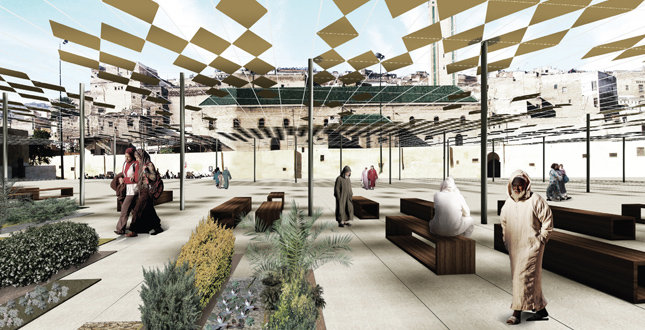 Close Me!
Close Me!Site 1: R'cif Plaza. The R’cif sits above a portion of the river that was paved over when Morocco was still a French protectorate. As the medina’s main intermodal hub, the site was one large paved surface brimming with organized chaos. Cars, motorbikes, donkeys, and buses all occupied the same area, waiting to load and unload goods and people. With the elimination of vehicular access, the R’cif will become a major public plaza and a critical threshold for a new pedestrian river axis.
Download Hi-Res ImagePhoto 7 of 15
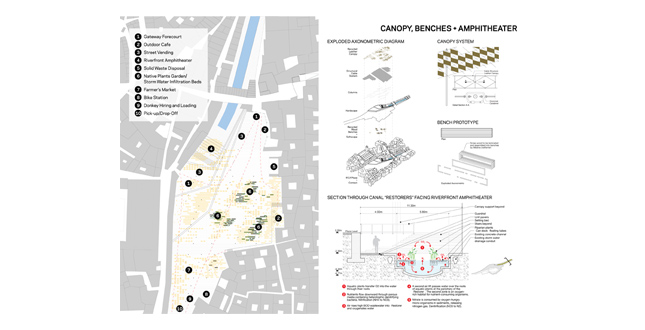 Close Me!
Close Me!Site 1: R'cif Plaza. Programs in the new R’cif Plaza include but are not limited to an amphitheater, outdoor cafés, a native garden that doubles as a stormwater infiltration zone, gateway forecourts, street vending, a farmer’s market, pickup and drop-off, and a zone to hire and load donkeys.
Download Hi-Res ImagePhoto 8 of 15
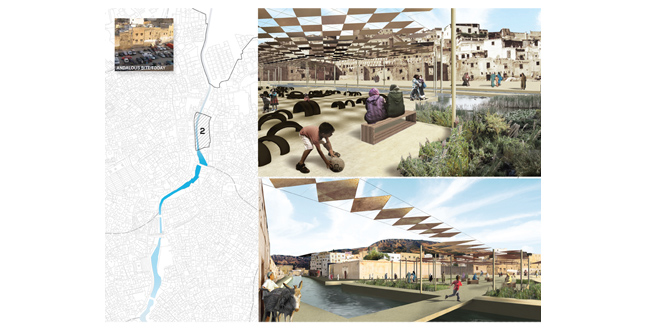 Close Me!
Close Me!Site 2: Andalous Playground. Before its current incarnation as a parking lot, the Andalous site was where hides from the Chouara Tanneries were laid out to dry. Thus, below the paving that now covers the site, chromium deposits from decades of use are presumably leaching toxins into the ground and into the aquifers. The Fez River Project proposes removal of the soils at the Andalous site for ex-situ phytoremediation and the importation of clean soils.
Download Hi-Res ImagePhoto 9 of 15
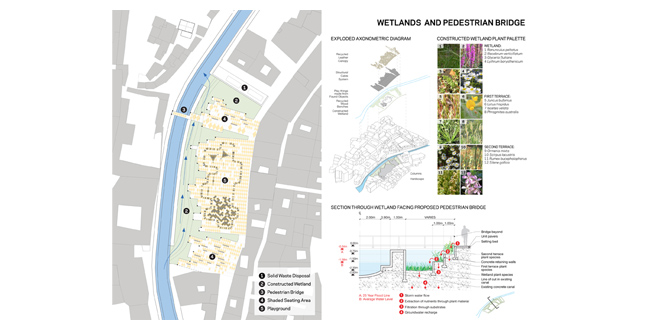 Close Me!
Close Me!Site 2: Andalous Playground. The site will become the medina’s first playground with site furnishings and play equipment created from salvaged materials. The Andalous Playground will also be characterized by a constructed wetland that will help clean the river and provide a new wildlife habitat. It will provide areas for passive recreation and serve as a demonstration garden for educating the public about the riparian ecosystem.
Download Hi-Res ImagePhoto 10 of 15
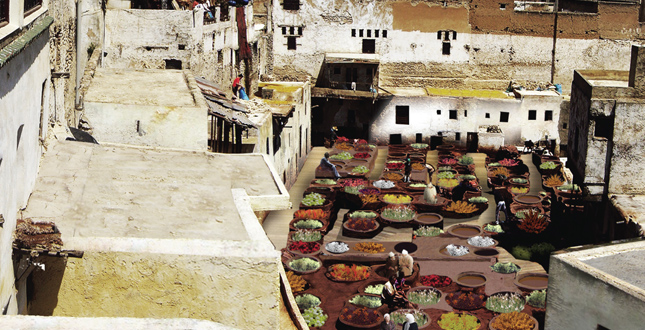 Close Me!
Close Me!Site 3: Chouara Leatherworks + Gardens. Predicated on removing a major point source of pollution and on revitalizing an embattled industry, the Chouara Tanneries will become the Chouara Leatherworks + Gardens. The leatherworks will provide training and information to would-be leather entrepreneurs with opportunities to learn from artists in residence.
Download Hi-Res ImagePhoto 11 of 15
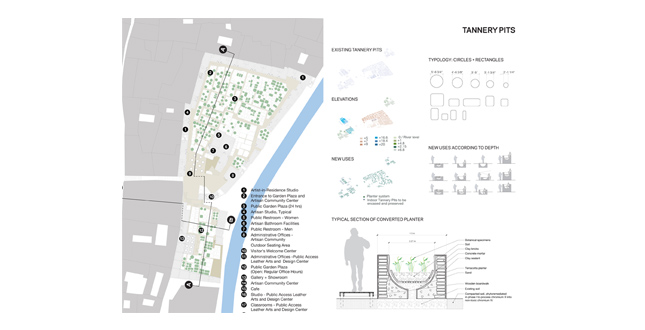 Close Me!
Close Me!Site 3: Chouara Leatherworks + Gardens. The central tannery area will become a public botanical garden that provides its visitors a respite from the bustle of the medina. A café will be shared amongst all who visit the new garden including medina residents and shoppers. During project implementation, the tanneries will also function as a nursery for propagating riparian plants to be planted along the river and in the constructed wetlands.
Download Hi-Res ImagePhoto 12 of 15
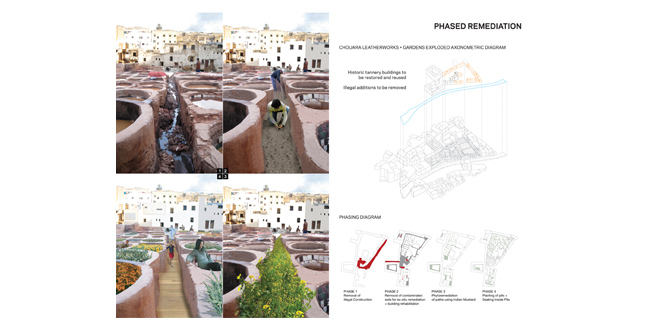 Close Me!
Close Me!Phased Remediation. Chouara Leatherworks + Gardens exploded axonometric diagram.
Download Hi-Res ImagePhoto 13 of 15
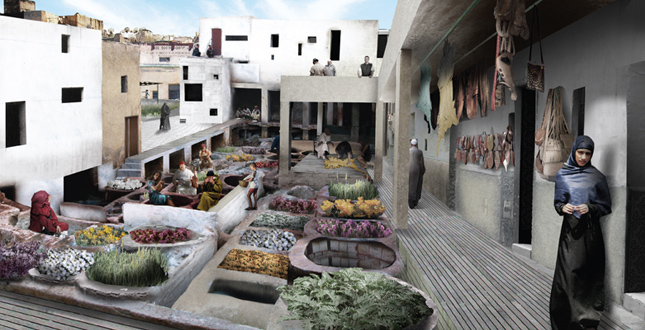 Close Me!
Close Me!View of proposed Chouara Leatherworks Gallery and Showrooms
Download Hi-Res ImagePhoto 14 of 15
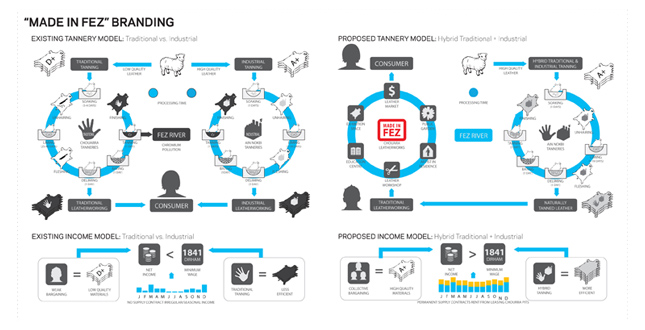 Close Me!
Close Me!"Made in Fez" Branding
Download Hi-Res ImagePhoto 15 of 15
Project Statement
Utilizing Fez, Morocco as a case study, we envisioned a strategic plan that simultaneously restores an urban river and addresses issues endemic to aging medieval fabrics such as the scarcity of open space, overcrowding, a weak economy, and the destruction of natural resources and places of cultural and historic significance. We choreographed a phased implementation strategy in which measures for enhancing water quality become both the locus and agent for addressing social and economic concerns.
Project Narrative
—2010 Professional Awards Jury
UNESCO's impetus for designating entire medinas as World Heritage sites lies in their distinctive ensemble of historic monuments, cultural vitality, and enduring economic activity. In 1981, the Medina of Fez was the first of its kind to be bestowed the World Heritage designation. In the words of the UNESCO decision committee, "Fez is at once an astonishing city-museum and one of the largest Islamic metropolises where the various demographic strata have determined the greatest variety of architectural forms and urban landscapes." For over a millennium, the medinas' unique morphology has proven resilient to social, economic, and political upheavals. Though recently eclipsed by the extraordinary boom of Doha, Dubai and other urban centers on the Arabian Peninsula, medinas still possess a poignant relevance, as compelling examples of the ecologically sustainable metropolis. Thousand-year-old cities as models for contemporary urbanism may seem ironic; however, a comprehensive pedestrian network, a dense and heterogeneous urban fabric that nurtures strong microcommunities, and architectural forms that maximize passive cooling in a hot and arid region distinguish medinas within urban typology as a model to which many cities aspire. But the model is far from perfect, and the medinas' capacity to absorb change without rupturing urban form is proving finite. Rapid urbanization, modernization, globalization, and the introduction of planning and urban typology from Europe and North America have caused unprecedented change to the cultural habits of populations throughout the Arab world and are prompting demands for amenities foreign to the medieval fabric of medinas.
The Medina of Fez emerged in 808 AD as two separate nuclei on either sides of a free-flowing river. By the 12th century, the two towns had fused into one, but Oued Fes (Fez River) remained the city's spine and integral to its urbanism. Over the course of centuries, the city's dependence on the river to support a growing population and a flourishing leather tanning industry severely impacted water quality. By the 1950s the river had degenerated into a sewage channel and was renamed Oued Boukrareb (Trash River). Portions of the river were paved over consequently allowing vehicular access to disrupt the world's most comprehensive pedestrian network. The river was obscured further in 2004 through ad hoc construction and again in 2007 extending further vehicular access into the medina. Today, residents, tourists, and workers in the medina think the river is either a blight or don't even know that it exists.
The City of Fez Department of Water and Power (RADEEF) is in the process of constructing two new sewage treatment facilities to free the river from further deterioration. Aligned with this initiative, we worked with the RADEEF to create a rehabilitation plan for the river. Taking into consideration problems that plague the medina including but not limited to the lack of basic public services, the shortage of public open space, overcrowding, aging infrastructure, the destruction of places of cultural and historic significance, localized gentrification for tourism, environmental degradation, illegal dumping, and increased vehicular access into the medina, this project is a strategic plan that addresses not only the ecology of a river but also the social and economic concerns of a city. Based on an analysis of Fez's urban and ecological context, the project at the city scale (city of Fez including the Ville Nouvelle and the medina) is a master plan with recommended measures for improving regional water quality. At site scale (parcels within the medina), the project is three critical interventions each with its own specific purpose and identity strategically phased to enhance water quality, remediate contaminated sites, create open spaces, and to build on existing resources for economic development. The overall effect is a project that elevates the river to a multiperformative urban infrastructure that possesses the potential to stitch or blend disjuncture between the needs of a 21st-century population and the historicist imperatives necessary to preserve the integrity of a UNESCO World Heritage designation.
The City of Fez is located in one of Morocco's most fertile valleys, the Sebou River basin. The river basin is home to a diverse range of ecosystems as it directs surface water from the High Atlas Mountains to the sea. Generous annual rainfall is channeled through a dense hydrological network that feeds fertile agricultural lands. Agricultural cultivation consumes more than 95 percent of the basin's fresh water supply. With rising agricultural and industrial pollution, crops, soils and groundwater face greater contamination risk. Peak levels of pollution in the Sebou River basin occur immediately downstream of the city of Fez. The project repositions the medina to not only overcome its current negative impacts but to become a proactive component for improving the ecological quality of the region. Thus, the project not only reduces or eliminates contaminants flowing into the river but also actively cleans the water that flows through it. It not only remediates contaminated soils but also creates a new public botanical garden and a nursery for propagating riparian plants (to be utilized along the river and in newly constructed wetlands). The constructed wetlands will not only help manage excess floodwater, cleanse stormwater, and nurture new wildlife habitats but will also serve as tools for educating the public about healthy ecosystems.
The project also recommends restructuring the leather industry within the medina. Despite being a part of Fez's biggest tourist attraction, tannery workers in the medina receive less than minimum wage while working in substandard conditions. Like many before us, we propose to shift the tanning stages of leather production to remote facilities. At Ain Nokbi, reclamation of industrial chemicals would mitigate pollution and mechanizations of certain procedures would minimize a tannery worker's exposure to toxins. Where our approach differs from that of our predecessors' is our idea to maintain direct linkage between the displaced tannery workers and the Chouara Tanneries, thus preserving continuity in this heritage industry. Our collaborators conceived of the "Made in Fez" brand to create leather products focused on niche markets that value sustainability (both environmental and social), quality, and innovation. Instead of attempting direct price competition with players like China, the "Made in Fez" brand will benefit financially both the tannery workers and the leather craftsmen. The two are vertically integrated in a supply chain in which the former are assured a higher paying market for their naturally dyed, high quality leather, and the latter are able to provide a superior artisanal product based on a secure and environmentally sustainable supply. With support from the Municipality of Fez and the Ministry of Tourism and Craft, the "Made in Fez" brand can be made the focus of an annual crafts festival in the medina and attract artists in residence from beyond the Moroccan border. By spatializing the "Made in Fez" label specifically to the medina, we can expect a new craft culture to emerge from within its walls. Once vacated, the tanneries would be rehabilitated for reuse as botanical gardens, workshops and studios, community center, education center, and other communal facilities shared by leather workers and visitors to the leather district.
High unemployment has made the medina a target for industries looking to exploit its resources. While the commissioned objective is to restore a river, this project is in fact a framework for improving the quality of life within the medina. Although community workshops are nascent in Morocco, this is our preferred medium for soliciting public participation and endowing the community with pride of ownership. As professionals, academics, and experts, we aim to facilitate translation of community vision into built form. Fostering a collaborative relationship from inception, we remain in contact with the AMCE—an environmental science and technology advancement group; a Debbaghas (Tanners' corporation) liaison; ADER Fes—the agency responsible for coordinating historic restoration and rehabilitation programs in the medina; the Moroccan Ministry of Tourism and Crafts; and the Mayor's Office of the City of Fez.
Project Resources
Bureau E.A.S.T. Team
Takako Tajima, Associate ASLA, Aziza Chaouni, Vesna Kann, Nicko Elliott, Dennis Rijkhoff, Carolyn Matsumoto, Zineb Alaoui, Bassima Jazouli
Landscape Systems
Reem Alissa, PhD candidate, UC Berkeley
Industrial Districts
Marco Cenzatti, Lecturer in Architecture
College of Environmental Design, UC Berkeley
Construction
John Ferri, Specialized Construction,
Los Angeles USA
Historic Preservation and Restoration in the Medina of Fez
Bonnie Kaplan, Medina Solutions, Fez, Morocco
Historian
Alex Toshkov, PhD candidate, Columbia University
Marketing and Branding
Hester Ezra, Design Researcher/Project Manager, Butterfly Works, Amsterdam, The Netherlands
Economic Redevelopment in Developing Countries
Faiza Zemmouri, Economist, Fez, Morocco






